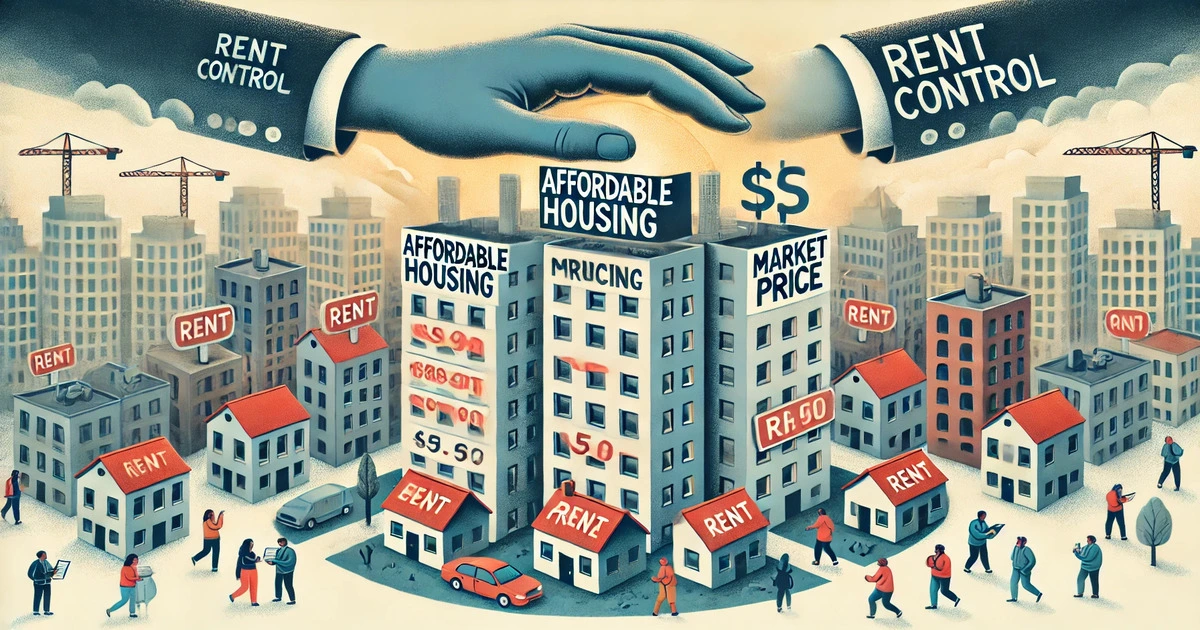The Impact of Rent Controls on the UK Private Rental Sector: A Comprehensive Analysis
The introduction of rent controls in the UK private rental sector is a topic that has sparked significant debate among policymakers, landlords, and tenants alike.
As the housing crisis continues to put pressure on renters, proposals for rent controls have gained traction as a potential solution. However, these controls may also lead to unintended consequences, particularly for landlords.
In this article, we will explore the implications of rent controls on the private rental market, with a focus on how these measures could affect landlords, tenants, and the broader housing market.
Understanding Rent Controls and Their Purpose
Rent controls are government-imposed regulations that limit the amount landlords can charge for renting out their properties.
The primary goal of rent controls is to make housing more affordable for tenants, especially in areas where rents have skyrocketed due to high demand and limited supply.
Rent controls can take various forms, including rent caps, which limit the maximum amount that can be charged for rent, and rent stabilisation, which regulates the rate at which rent can be increased over time.
While the intention behind rent controls is to protect tenants from excessive rent hikes and housing insecurity, the implementation of such measures can have far-reaching consequences for the private rental sector.
The Potential Impact of Rent Controls on Landlords
Reduced Incentives for Landlords
One of the most significant concerns surrounding rent controls is the potential reduction in incentives for landlords to invest in rental properties.
When rent controls are in place, landlords may face limitations on the returns they can earn from their investments.
This could lead to a decrease in the number of rental properties available, as landlords may choose to sell their properties or shift their investments to other sectors where returns are not capped by regulation.
The British Landlords Association CEO, Mr Sajjad Ahmad, has said: “High rents are a direct consequence of the failed housing policy of the conservative government.
The failed attempt to abolish the Section 21 notice spooked many landlords, who started selling up before the legislation came in. The consequences of this have been a sharp rise in rents“
Deterioration of Property Maintenance
Rent controls can also lead to a decline in property maintenance and quality. Landlords who are unable to charge market rates for rent may find it financially challenging to maintain their properties to a high standard.
Over time, this can result in a deterioration of the rental housing stock, as landlords may cut back on repairs and renovations to save costs. This could ultimately harm tenants, who may be forced to live in substandard housing conditions.
Landlords Exiting the Market
In some cases, the introduction of rent controls may prompt landlords to exit the rental market altogether.
Faced with reduced profitability and increased regulatory burdens, some landlords may decide that renting out properties is no longer a viable option.
This could lead to a reduction in the supply of rental housing, exacerbating the housing crisis rather than alleviating it.
According to recent survey conducted by the British Landlords Association (The BLA), a significant proportion of landlords indicated that they would consider selling their properties if rent controls were introduced.
This trend could have a ripple effect across the housing market, as a sudden influx of properties for sale could impact house prices and the availability of rental housing.
The Broader Implications for the UK Housing Market
Supply and Demand Imbalance
Rent controls can disrupt the delicate balance of supply and demand in the housing market. By capping rents, the supply of rental properties may decrease as landlords exit the market or reduce their investments.
At the same time, demand for rental properties may increase as more tenants seek affordable housing options.
This imbalance could lead to a shortage of rental properties, making it more challenging for tenants to find suitable accommodation.
Impact on New Construction
The introduction of rent controls could also deter developers from building new rental properties. If developers perceive that their potential returns will be limited by rent controls, they may choose to invest in other types of properties or projects.
This could lead to a slowdown in the construction of new rental housing, further exacerbating the shortage of rental properties and pushing up prices in the long term.
Economic Consequences
The economic implications of rent controls extend beyond the housing market. Reduced investment in the rental sector can lead to a decrease in construction activity, which in turn affects jobs and economic growth.
Additionally, a decline in property values resulting from an oversupply of homes on the market could have broader economic repercussions, particularly for homeowners and investors.
Alternatives to Rent Controls
Given the potential drawbacks of rent controls, it is essential to consider alternative solutions that can address the affordability crisis without causing unintended harm to the private rental sector. Some potential alternatives include:
- Increased Housing Supply: One of the most effective ways to address the affordability crisis is to increase the supply of housing. This can be achieved through measures such as relaxing planning regulations, providing incentives for developers to build affordable housing, and investing in social housing.
- Targeted Rental Assistance: Instead of imposing rent controls, governments can provide targeted rental assistance to low-income tenants. This can help tenants afford housing without distorting the market dynamics that drive investment and construction.
- Incentivising Landlord Participation: Governments can offer incentives to landlords who provide affordable housing or maintain their properties to a high standard. This could include tax breaks, grants, or other forms of financial assistance.
Conclusion: Balancing Tenant Protection with Market Sustainability
The debate over rent controls in the UK private rental sector is complex, with valid arguments on both sides.
While rent controls may offer short-term relief for tenants facing rising rents, they also carry the risk of reducing the supply and quality of rental housing.
As policymakers consider the implementation of rent controls, it is crucial to balance the need for tenant protection with the sustainability of the rental market.
By exploring alternative solutions and carefully assessing the potential consequences of rent controls, the UK can work towards a housing market that is both affordable and resilient.
This article provides a detailed examination of the potential impacts of rent controls on the UK private rental sector.
By understanding these dynamics, stakeholders can engage in informed discussions and work towards solutions that address the housing crisis without undermining the stability of the rental market.
Case Studies: Rent Controls in Other Countries
To fully understand the potential effects of rent controls on the UK private rental sector, it is helpful to examine case studies from other countries where such measures have been implemented.
These examples can provide valuable insights into both the successes and challenges associated with rent controls.
Germany: Rent Controls and Long-Term Tenancies
Germany is often cited as a country with a successful model of rent controls. The country has a system of rent regulation that allows for moderate rent increases, linked to inflation and local market conditions.
This system has led to a stable rental market with long-term tenancies, providing tenants with security and predictability.
However, critics argue that Germany’s rent controls have also contributed to a shortage of rental properties in high-demand areas, such as Berlin.
In these cities, rent caps have made it difficult for landlords to cover costs, leading to a slowdown in new housing development.
As a result, tenants in these areas still face challenges in finding affordable housing despite the rent control measures.
New York City: A Mixed Legacy of Rent Stabilisation
New York City has a long history of rent controls, particularly through its rent stabilisation program. Under this program, landlords are limited in how much they can increase rents each year for certain apartments.
While this has provided tenants with some degree of protection from rising rents, the system has also led to several unintended consequences.
One of the main issues in New York has been the distortion of the housing market. Rent-controlled apartments are often underpriced compared to market rates, leading to a shortage of available units.
This has resulted in long waiting lists and a black market for rent-controlled apartments, where tenants sometimes sell their leases for a premium.
Additionally, the quality of rent-controlled housing has declined over time as landlords struggle to maintain properties with limited rental income.
Sweden: Comprehensive Rent Controls and Housing Shortages
Sweden has one of the most comprehensive rent control systems in the world, with rents negotiated collectively between tenant associations and landlords.
While this system has kept rents relatively low, it has also led to significant housing shortages, particularly in major cities like Stockholm.
The Swedish system has created a dual market: a regulated rental market with low rents and a parallel black market where tenants pay large sums for rental contracts.
Additionally, the shortage of available rental housing has forced many people to rely on the more expensive and less secure private rental market, exacerbating inequality.
Lessons Learned from International Case Studies
The experiences of countries like Germany, New York City, and Sweden highlight the complex trade-offs associated with rent controls.
While these measures can provide short-term relief for tenants, they can also lead to long-term challenges, such as housing shortages, reduced investment in the rental market, and the deterioration of housing quality.
These case studies underscore the importance of carefully designing rent control policies to avoid these pitfalls.
The Future of Rent Controls in the UK
As the debate over rent controls continues in the UK, it is crucial for policymakers to consider both the potential benefits and risks.
The experiences of other countries show that while rent controls can help protect tenants in the short term, they can also have unintended consequences that may worsen housing affordability in the long run.
For rent controls to be successful in the UK, they would need to be implemented alongside other measures that address the underlying issues in the housing market.
This could include increasing the supply of affordable housing, providing financial incentives for landlords to maintain and invest in their properties, and offering targeted assistance to those most in need.
Moreover, any rent control measures should be carefully monitored and adjusted as needed to ensure that they do not lead to negative outcomes such as a decline in housing quality or a reduction in the supply of rental properties.
Final Thoughts: A Balanced Approach to Housing Affordability
The question of whether to introduce rent controls in the UK is a complex one, with no easy answers.
On one hand, rent controls can provide much-needed relief for tenants facing rising rents and housing insecurity. On the other hand, these measures can also lead to unintended consequences that may ultimately harm both tenants and landlords.
A balanced approach that combines tenant protections with measures to encourage investment in the rental market is essential.
By addressing the root causes of the housing crisis and ensuring that rent controls are part of a broader strategy to improve housing affordability, the UK can work towards a fairer and more sustainable rental market.
In conclusion, while rent controls may offer a temporary solution to the affordability crisis, they are not a panacea.
A comprehensive and multifaceted approach is needed to ensure that both tenants and landlords can thrive in a stable and equitable housing market.
This article offers a thorough exploration of rent controls in the UK and abroad, providing insights into their potential impact and outlining alternative approaches to improving housing affordability.
The inclusion of international case studies and a focus on balanced solutions makes this piece a valuable resource for anyone interested in the future of the UK private rental sector.
Key Statistics on the UK Private Rental Sector and Rent Controls
To better understand the implications of rent controls in the UK private rental sector, it is essential to examine relevant statistics.
These figures provide insight into the current state of the market, the challenges faced by tenants and landlords, and the potential impact of regulatory changes.
UK Private Rental Sector Overview
Size of the Private Rental Market: As of 2023, approximately 4.4 million households in the UK, or about 19% of all households, are in the private rental sector. This represents a significant increase from around 2.8 million households in 2007, highlighting the growing importance of the rental market in the UK housing landscape.
Average Rent Costs: The average rent for a property in the UK is around £1,100 per month, with significant regional variations. For example, in London, the average monthly rent exceeds £1,500, while in the North East, it is closer to £600. These disparities reflect the differing levels of demand and housing supply across the country.
Rent Increases: Rents in the UK have been rising steadily. Between 2010 and 2022, average rents increased by approximately 30%, outpacing wage growth in many areas. This has put significant financial pressure on tenants, particularly in high-demand urban areas.
Tenant Demographics: The private rental sector is home to a diverse population. Around 35% of private renters are aged 25-34, and a growing proportion are families with children, reflecting a shift from homeownership to renting among younger generations.
Landlord Data and Market Dynamics
Number of Landlords: There are an estimated 2.66 million landlords in the UK, with most owning just one or two properties. Around 45% of landlords are classified as “accidental landlords,” meaning they did not originally intend to rent out property but ended up doing so due to various circumstances.
- Landlord Profit Margins: On average, landlords in the UK earn a rental yield of around 3.5% to 5% on their properties. However, after accounting for expenses such as mortgage payments, maintenance, and taxes, many landlords report that their net profit margins are relatively slim, particularly in regions with lower rental yields.
- Potential Impact of Rent Controls: Surveys conducted by landlord associations suggest that if rent controls were introduced, up to 45% of landlords would consider selling their rental properties. This could lead to a significant reduction in the availability of rental homes, particularly in already undersupplied markets.
Housing Affordability and the Impact on Tenants
- Rent as a Proportion of Income: On average, tenants in the UK spend around 30-40% of their income on rent. In London, this figure can rise to over 50%, making housing affordability a significant issue for many renters. High rental costs limit tenants’ ability to save for a deposit and transition to homeownership.
- Housing Benefit Recipients: Approximately 1.5 million households in the private rental sector receive housing benefits to help cover their rent. However, in many cases, housing benefit payments do not fully cover the cost of rent, leaving tenants to make up the difference out of pocket.
- Homelessness and Housing Insecurity: Rising rents and a lack of affordable housing have contributed to increasing levels of homelessness and housing insecurity. In 2022, over 270,000 households in England were considered to be homeless or at risk of homelessness, with a significant proportion citing the end of a private tenancy as the primary reason.
Comparative International Statistics
- Germany: In Germany, where rent controls and rent stabilisation are more common, tenants spend around 25-30% of their income on rent, compared to higher proportions in the UK. However, the German rental market also faces challenges, such as housing shortages in major cities like Berlin.
- New York City: In New York, around 45% of rental units are subject to rent stabilisation. Despite these controls, the city still experiences high rents, with the average renter spending over 40% of their income on housing.
- Sweden: Sweden’s comprehensive rent controls have kept rents relatively low, with tenants spending about 20-25% of their income on rent. However, the country also faces a severe housing shortage, with waiting times for rental properties in Stockholm often exceeding 10 years.
Conclusion: The Statistical Case for Careful Consideration
The statistics surrounding the UK private rental sector highlight the challenges of balancing tenant affordability with the sustainability of the rental market.
With rents rising faster than wages and many tenants spending a significant portion of their income on housing, the appeal of rent controls is understandable.
However, the data also suggests that such measures could lead to a reduction in the supply of rental properties, exacerbating the very problems they aim to solve.
As the UK continues to grapple with housing affordability issues, it is crucial for policymakers to carefully weigh the statistical evidence and consider a range of solutions, including increasing housing supply and offering targeted assistance to those most in need.
By taking a data-driven approach, the UK can work towards creating a more equitable and sustainable rental market for all.
FAQ About Rent Controls in the UK Private Rental Sector
What are rent controls?
Rent controls are government-imposed regulations that limit the amount landlords can charge for renting out their properties.
They are designed to make housing more affordable for tenants by capping rent prices or regulating how much rent can increase over time.
How do rent controls work?
Rent controls can take several forms:
- Rent caps: These set a maximum limit on the amount that can be charged for rent.
- Rent stabilisation: This limits the rate at which rent can be increased each year.
- Vacancy controls: These regulate rent levels even after a tenant vacates the property, preventing landlords from significantly increasing the rent for new tenants.
Why are rent controls being considered in the UK?
Rent controls are being considered in response to rising rents and the growing housing affordability crisis.
Many tenants are struggling with high rent costs, particularly in urban areas where demand for housing outstrips supply. Rent controls are seen as a way to protect tenants from excessive rent increases and housing insecurity.
What are the potential benefits of rent controls?
The primary benefit of rent controls is increased housing affordability for tenants. By capping rents, tenants are protected from sudden rent hikes and can have more financial stability.
Rent controls can also help prevent displacement in gentrifying neighbourhoods, allowing long-term residents to remain in their homes.
What are the potential drawbacks of rent controls?
There are several potential drawbacks to rent controls:
- Reduced supply of rental properties: Landlords may sell their properties or convert them to other uses, leading to fewer available rental homes.
- Decreased investment in property maintenance: Landlords may be less willing or able to invest in maintaining or upgrading their properties if their rental income is capped.
- Distorted housing market: Rent controls can lead to mismatches between supply and demand, resulting in housing shortages and long waiting lists for rent-controlled properties.
How have rent controls worked in other countries?
Rent controls have been implemented in various forms in countries like Germany, New York (USA), and Sweden, with mixed results:
- Germany: Rent controls have contributed to stable rents but have also led to housing shortages in high-demand areas.
- New York City: Rent stabilisation has protected some tenants from rising rents but has also created a black market for rent-controlled apartments and reduced the quality of rental housing.
- Sweden: Comprehensive rent controls have kept rents low but have resulted in severe housing shortages, particularly in cities like Stockholm.
Will rent controls lead to a decline in property quality?
There is a risk that rent controls could lead to a decline in property quality.
If landlords cannot charge market rents, they may have less incentive or financial ability to invest in property maintenance and improvements. Over time, this could result in a deterioration of the rental housing stock.
How might rent controls affect landlords?
Rent controls can impact landlords by reducing their rental income and profit margins. This may lead some landlords to exit the rental market, reducing the overall supply of rental properties.
Additionally, landlords may be less willing to invest in property upgrades or expand their rental portfolios.
What alternatives to rent controls exist?
Alternatives to rent controls include:
- Increasing the housing supply: Building more affordable housing can help address the root causes of high rents.
- Targeted rental assistance: Providing financial support directly to tenants in need can help them afford housing without distorting market dynamics.
- Incentivising affordable rentals: Offering tax breaks or subsidies to landlords who provide affordable housing can encourage the development and maintenance of affordable rental properties.
What should tenants and landlords do if rent controls are introduced?
If rent controls are introduced, tenants should familiarise themselves with the new regulations and understand their rights and responsibilities.
Landlords should review their rental agreements and financial plans to ensure compliance with the new laws. Both parties may benefit from seeking legal or financial advice to navigate the changes.
How can rent controls impact new housing developments?
Rent controls can deter new housing developments if developers believe their potential returns will be limited by rent caps. This could slow down the construction of new rental properties, exacerbating the housing shortage in the long term.
Are there any regions in the UK currently implementing rent controls?
As of now, rent controls are not widely implemented in the UK. However, the Scottish government has introduced temporary rent controls as part of emergency measures in response to the cost of living crisis, and other regions are considering similar policies.
What is the future outlook for rent controls in the UK?
The future of rent controls in the UK remains uncertain.
While there is growing support for such measures among some policymakers and tenant advocacy groups, there is also significant opposition from landlords and industry experts who warn of potential negative consequences.
The debate is likely to continue as the housing crisis persists.
This FAQ provides a comprehensive overview of the key questions surrounding rent controls in the UK private rental sector, helping both tenants and landlords understand the potential implications of these policies.
Useful Links on Rent Controls and the UK Private Rental Sector
Here are some useful links to resources and articles that provide more information on rent controls and the UK private rental sector:
- UK Government Housing Policy
- UK Government Housing and Renting Policy
- Official government resources and updates on renting laws and housing policy in the UK.
- British Landlords Association (The BLA)
- The BLA – Rent Controls
- The British Landlords Association offers insights and research on the impact of rent controls on landlords and the rental market.
- Crisis – Homelessness Charity
- Crisis – Housing Issues
- Crisis focuses on homelessness and provides information on housing affordability and the impact of rent policies.
- Institute for Fiscal Studies (IFS)
- IFS – Rent Controls and Housing Market Analysis
- Research and reports on the economic implications of rent controls and housing market interventions.
These links provide a wealth of information from various perspectives, including government resources, landlord associations, tenant advocacy groups, and academic research.
They are valuable resources for anyone looking to deepen their understanding of rent controls and the UK private rental sector.
The British Landlords Association is a national landlord association for UK landlords and one of the largest landlord associations in the UK. Join us now for £79.95!
Our top read blogs:
Scotland’s Landlord Exodus and Rental Market Crisis
What is the Process of Renting a Shop
Maintenance Tips to Keep Your Rental Property in Prime Condition
Disclaimer:
This post is for general use only and is not intended to offer legal, tax, or investment advice; it may be out of date, incorrect, or maybe a guest post. You are required to seek legal advice from a solicitor before acting on anything written hereinabove.





